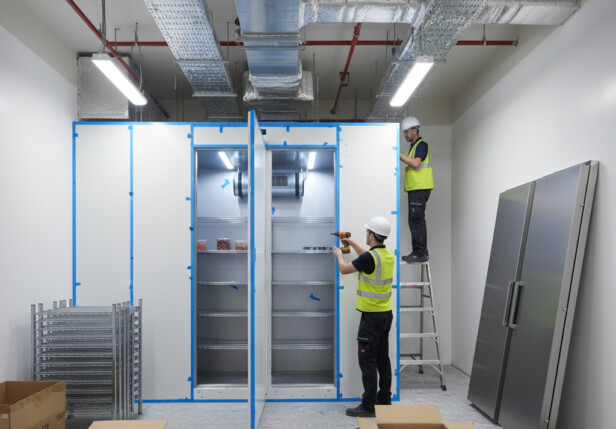Commercial refrigeration systems fail when they lack proper documentation and maintenance protocols. Walk-in cooler code compliance in San Antonio requires precise attention to installation standards, operational safety measures, and comprehensive record keeping that supports both daily operations and regulatory inspections.
This comprehensive guide covers essential component verification procedures, documentation requirements from the EB3 Construction manual, and troubleshooting protocols that ensure regulatory compliance. We examine the critical inspection points that determine whether your refrigeration system meets San Antonio’s commercial cooling standards.
Which Walk-In Cooler Components Should You Check First For Compliance?

Door hardware represents the first checkpoint when we assess walk-in cooler compliance. Door hinges must secure tightly without excessive play or misalignment. Locks should engage fully with proper tension, creating a complete seal when the door closes. Door seals require inspection for cracks, gaps, and brittleness that compromise cold air retention.
Panel seams deserve immediate attention during compliance checks. Insulation panels need solid connections where they meet. We examine each joint for proper tongue-and-groove alignment and check that gaskets maintain their seal integrity. Gaps in panel seams allow air infiltration that forces refrigeration systems to work harder.
Interior fixtures provide clear visual indicators of system performance. Bright lighting confirms electrical connections work properly and heat generation stays within acceptable limits. Metal shelves should mount securely with stable support brackets that handle expected loads. Poor lighting or unstable shelving signals deeper maintenance issues that affect compliance.
The refrigeration unit forms the core of any compliance inspection. We verify normal operation by listening for consistent compressor cycles and checking that evaporator fans rotate freely. Temperature readings should align with thermostat settings. Ice buildup on coils indicates defrost problems that require attention.
Rooftop condensers need accessibility and proper operation when installed. We confirm mounting stability and adequate clearance for airflow. Condenser fans should rotate without excessive noise or vibration. Refrigerant lines connecting to the rooftop unit require secure fastening and proper insulation to prevent energy loss.
How Does The EB3 Construction Manual Help With Code Compliance?
The EB3 Construction manual serves as your primary resource for maintaining proper operation and meeting compliance requirements. This comprehensive documentation includes installation instructions, troubleshooting procedures, warranty information, and detailed drawings.
Installation Instructions Verify Proper Setup
We use the installation instructions to confirm each walk-in cooler unit matches its intended design specifications. These step-by-step procedures outline proper panel assembly, door alignment, and refrigeration connections. Following the manufacturer guidance ensures the system operates within design parameters from day one.
The installation section also covers electrical requirements and safety protocols. We reference these specifications during inspections to verify compliance with local codes and manufacturer standards.
Troubleshooting Procedures Address Performance Issues
When coolers experience operational problems, the troubleshooting section provides systematic diagnostic steps. These procedures help identify common issues like temperature fluctuations, door seal problems, or refrigeration malfunctions. We follow the documented troubleshooting sequence to pinpoint problems quickly and accurately.
The troubleshooting guide includes specific temperature ranges and performance benchmarks. This information helps determine whether repairs restore the unit to compliant operation or require further intervention.
Warranty Information Protects Your Investment
We maintain warranty details as part of our service records for each installation. The warranty section specifies coverage periods, service requirements, and authorized repair procedures. This documentation proves essential during warranty claims and helps track maintenance obligations.
Warranty information also includes contact details for manufacturer support and authorized service providers. Having this information readily available speeds resolution of complex technical issues.
Drawings Provide Layout Reference
Technical drawings show the as-built reference for each cooler installation. These detailed plans include panel layouts, door configurations, and equipment locations. We store these drawings for layout verification during inspections and future modifications.
The drawings also document electrical and refrigeration connections. This information proves valuable when troubleshooting system problems or planning upgrades to existing installations.
Organized Documentation Supports Compliance Reviews
We keep all manual components together in a single, accessible location for each project. This organization ensures inspectors can quickly review installation procedures, verify warranty status, and understand system specifications. Proper documentation management demonstrates our commitment to maintaining compliant operations throughout the cooler’s service life.
What Signs Suggest A Walk-In Cooler May Not Meet Compliance Expectations?
Several warning signs point to potential compliance issues that require immediate attention. Inadequate cooling performance represents the most critical indicator of system failure. When a walk-in cooler fails to maintain proper temperature, we investigate the refrigeration unit, check thermostat settings, and examine the defrost cycle operation.
Door seal integrity affects both temperature control and energy efficiency. Damaged gaskets allow warm air infiltration, creating temperature fluctuations that compromise food safety standards. We inspect door seals for cracks, gaps, or brittleness that prevent proper closure. Doors that fail to hold conditions signal compromised panel integrity or faulty hardware requiring prompt repair.
Insulation panel damage creates thermal bridges that reduce cooling efficiency. Gaps between panels, damaged seams, or deteriorated foam core insulation allow heat transfer into the cooled space. We examine panel connections for separation, check corner joints for air leaks, and assess overall structural integrity.
Maintenance equipment staged near the cooler indicates active service requirements. Service activity suggests ongoing operational issues that may affect compliance status. We document any temporary repairs, replacement components, or diagnostic equipment present during inspections to understand system reliability and maintenance history.
Using our troubleshooting guidance and as-built drawings helps identify root causes efficiently. These documents provide systematic diagnostic steps and component specifications for accurate problem resolution. We follow established procedures to isolate issues, verify repairs, and maintain detailed service records that support compliance documentation requirements.
Conclusion And Next Steps

Walk-in cooler code compliance in San Antonio requires systematic attention to essential components and thorough documentation. We prioritize door hardware integrity, insulation panel seams, functional lighting systems, stable shelving units, refrigeration equipment performance, and rooftop condenser accessibility. These core elements form the foundation of any compliant installation.
The EB3 Construction manual serves as our central reference for installation procedures, troubleshooting protocols, warranty documentation, and technical drawings. When cooling issues emerge or maintenance equipment appears on-site, we document the problem immediately and track resolution steps through proper channels. This organized approach supports both routine inspections and long-term operational reliability for commercial food service facilities.
Ready to ensure your walk-in cooler meets San Antonio compliance standards? Contact EB3 Construction for expert guidance on commercial refrigeration installations.




